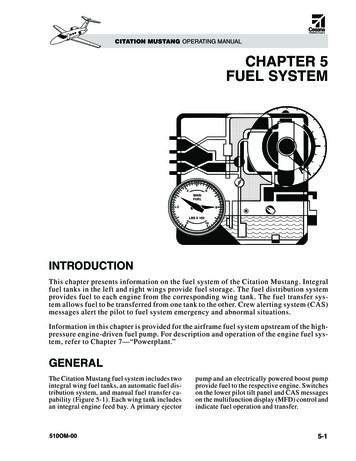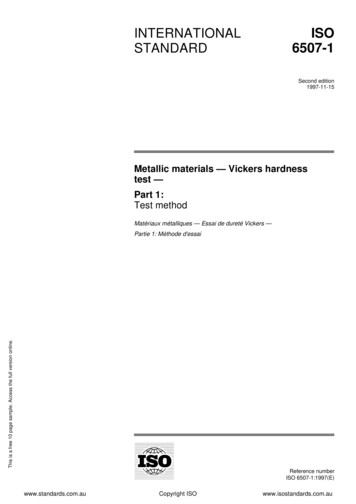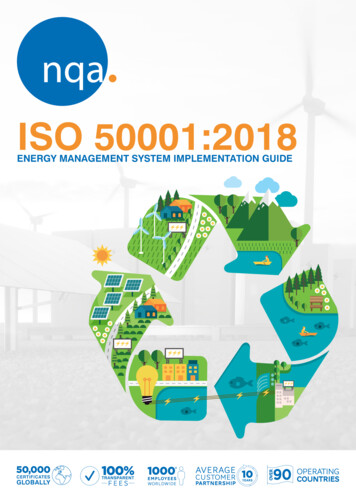
Transcription
OperationalFuel-SecurityAnalysisFor DiscussionJ A N U A R Y 1 7, 2 0 1 8ISO-NE PUBLICISO-NE PUBLICISO New England Operational Fuel-Security Analysis1
ContentsFigures 3Tables 3Highlights 4Executive Summary 6Background 6The Study 7Key Takeaways 8Next Steps 9Background: The Changing Grid and New England’s Fuel-Supply,Infrastructure, and Logistical Challenges 10The Changing Grid 11Logistical Uncertainties: Fuel Deliveries and Weather 14Natural Gas Delivery Challenges: Infrastructure Constraints and Contracts 16Operational Fuel-Security Analysis 18Study Description 18Overview of the Scenarios 22Key Resource Assumptions 23Methodology 28Metrics: How System Stress Was Measured 28Study Results 32Reference Case 33Single-Variable Scenarios 36Combination Scenarios 40Outage Scenarios 42Key Findings 47Conclusions 50Outages 50Stored Fuels: Imported LNG, Electricity Imports, and Dual-Fuel Capability 51Logistics 52Risk Trending in a Negative Direction 53More Renewables Help, but Don’t Eliminate the Risk 53More Positive Outcomes 542Next Steps 55Appendix A: Detailed Results 56ISO New England Operational Fuel-Security AnalysisISO-NE PUBLIC
FiguresFigure 1:2015 Annual Fuel Mix Compared with Day of Highest Coal and Oil Generation in 2015 12Figure 2:Winter LNG Deliveries to New England Interstate Pipelines 24Figure 3:Winter 2024/2025 Supply of Pipeline Gas and LNG Compared to Use (Reference Case) 25Figure 4: Hours of Emergency Actions under Modeled Scenarios, Ordered Least to Most 33Figure 5:36Projected Winter 2024/2025 Oil and LNG Use and Emergency Actions (Reference Case) Figure 6: Ranges of OP 4 Hours in Single-Variable Cases 37Figure 7:37Ranges of OP 7 Hours in Single-Variable Cases Figure 8: Projected Hours of Load Shedding due to Season-Long Outage of a Major Fuel or Energy Source(Reference Case Compared with the Max Scenario) 43Figure 9: Magnitude of Load Shedding in Modeled Cases 49TablesTable 1: Renewable Resource Assumptions 27Table 2:ISO Operating Procedure No. 4 Actions 30Table 3:Reference Case Assumptions and Results 35Table 4:Assumptions and Results for the Scenario with More Renewables Compared with the Reference Case 38Table 5:Assumptions and Results for the Scenarios with More and Less LNG Compared with the Reference Case 38Table 6:Assumptions and Results for the Scenarios with More and Less Imports Compared with the Reference Case 39Table 7: Assumptions and Results for the Scenarios with More and Less Dual-Fuel Replenishment Comparedwith the Reference Case 39Table 8:Assumptions and Results for the Scenario with More Retirements Compared with the Reference Case 40Table 9:Assumptions and Results for the Combination LNG Scenarios Compared with the Reference Case 41Table 10: Assumptions and Results for the Combination Scenario with High Retirements Compared withthe Reference Case 41Table 11: Assumptions and Results for the Combination Scenario with Maximum Retirements and RenewablesCompared with the Reference Case 42Table 12:Assumptions and Results for the Pipeline Compressor Outage Scenarios 44Table 13:Assumptions and Results for the Millstone Nuclear Outage Scenarios 45Table 14:Assumptions and Results for the Distrigas and Mystic 8 and 9 Outage Scenarios 46Table 15:Assumptions and Results for the Canaport LNG Outage Scenarios 46ISO-NE PUBLICISO New England Operational Fuel-Security Analysis3
Highlights: Operational Fuel-Security AnalysisFuel-security risk—the possibility that power plants won’t have or be able to get the fuel they need to run, particularly in winter—is the foremost challenge to a reliablepower grid in New England.ISO New England studied 23 possible future resource combinations during winter 2024/2025 to determine whether enough fuel would be available to meet demandand to understand the operational risks.The ISO chose winter 2024/2025 and 23 scenarios to depict a wide range of possible future power system conditions in the mid-2020s. Actual power gridconditions could change earlier or later than the 2024/2025 target winter.These scenarios, while not a precise prediction of the future system, seek to illustrate the range of potential risks that could confront a power system if fuel and energywere constrained during winter.The goal is to improve the ISO’s and the region’s understanding of these risks and inform the ISO’s subsequent discussions with stakeholders.The study assumed that no additional natural gas pipeline capacity to serve generators would be added within the timeframe of this study and instead focusedon five other variables that are likely to be key factors in power system reliability.Notable findings regarding each variable:4Resource RetirementsLNG AvailabilityOil Tank InventoriesThe retirements of coalfired, oil-fired, and nucleargenerators—resourceswith fuel stored on site—willhave a significant impact onreliability and magnify theimportance of other variables,particularly liquefied naturalgas (LNG) supplies.Improving generators’advance arrangementsfor timely winterdeliveries of LNG couldsignificantly reducefuel-security risk, whilereduced volumes ofthis global commoditywould raise risk.The availability of oilstored in tanks on site isa key reliability factor anddepends on the extent towhich natural-gas-firedgenerators are able to adddual-fuel capability to burnoil, how often they can runon oil, and whether theyhave oil when needed.Imported ElectricityRenewable ResourcesExpanding access toelectricity from neighboringpower systems wouldhelp mitigate fuel-securityrisk but would requireinvestment in transmissioninfrastructure.Accelerating the growth ofrenewable resources wouldenhance fuel security but wouldnot eliminate reliance on LNG. Italso would likely lead to more nongas-fired resource retirements andrequire transmission investment.ISO New England Operational Fuel-Security AnalysisISO-NE PUBLIC
Energy shortfalls due to inadequate fuel would occur with almost every fuel-mix scenario in winter 2024/2025, requiring frequent use of emergency actions tokeep power flowing and protect the grid. Emergency actions that would be visibleto the public range from requests for energy conservation to load shedding (rollingblackouts affecting blocks of customers).The study’s findings suggest six major conclusions: O utages: The region is vulnerable to the season-long outage of anyof several major energy facilities.S tored fuels: Power system reliability is heavily dependent onLNG and electricity imports; more dual-fuel capability is also a keyreliability factor, but permitting for construction and emissionsis difficult. Logistics: The timely availability of fuel is critical, highlighting theimportance of fuel-delivery logistics.R isk trends: All but four scenarios result in fuel shortages requiringload shedding, indicating the trends affecting New England’s powersystem may intensify the region’s fuel-security risk.R enewables: More renewable resources can help lessen the region’sfuel-security risk but are likely to drive coal- and oil-fired generationretirements, requiring high LNG imports to counteract the loss ofstored fuels.P ositive outcomes: Higher levels of LNG, imports, and renewablescan minimize system stress and maintain reliability; to attain thesehigher levels, delivery assurances for LNG and electricity imports, aswell as transmission expansion, will be needed.The ISO will discuss the study with regional stakeholders and determine whether further operational or market design measures are needed toaddress the region’s fuel-security risk.ISO-NE PUBLICISO New England Operational Fuel-Security Analysis5
ExecutiveSummaryThe health and safety of New England’s 14 million residents and the vibrancy of its economy depend on areliable power supply, and that requires fuel security—that is, a reliable supply of the various fuels used togenerate the region’s electricity. New England’s generation fleet relies primarily on fuels imported fromelsewhere in the United States or from overseas to produce power, giving fuel procurement,transportation, and storage a pivotal role in power system operations. This is particularly true during winterwhen fuel for nearly half the region’s generating capacity may become inaccessible due to priority demandfor natural gas from the heating sector.As the operator of the region’s six-state power system, ISO New England isrequired to plan and operate the grid to ensure a reliable supply of electricity.To help fulfill this responsibility, the ISO conducted a fuel-security analysisthat evaluated the level of operational risk posed to the power system by awide range of potential fuel-mix scenarios. The study quantified the risk bycalculating whether enough fuel would be available for the system to satisfyconsumer electricity demand and to maintain power system reliabilitythroughout an entire winter.Fuel-security risk—thepossibility that powerplants won’t have or beable to get the fuel theyneed to run, particularlyin winter—is theforemost challengeto a reliable power gridin New England.BackgroundOn multiple occasions in recent winters, the ISO has had to manage the system with uncertaintyabout whether power plants could arrange for the fuel—primarily natural gas—needed to run.1 Becausethe ISO has no jurisdiction over other industries’ various fuel-delivery systems, it has addressed theeffects of insufficient fuel supplies on the power system by employing real-time emergency operatingprocedures and implementing market design changes to incentivize generators to arrange for adequatefuel supplies. The ISO has also worked on improving communication and coordination with natural gaspipeline operators.The ISO has been able to maintain power system reliability during severe winter conditions without usingall its emergency procedures. However, the evolving generation mix is increasingly susceptible to variableand uncertain factors. Natural gas pipeline constraints, the logistics of importing liquefied natural gas (LNG)1. Winter 2003/2004: ISO New England Internal Market Monitor, Final Report on Electricity Supply Conditions in New England During the January 14-16, 2004 “ColdSnap” (October 12, 2004), 7/09/iso-ne final report jan2004 cold snap.pdf; Winter 2012/2013: ISO New England,“Winter Operations Summary: January–February 2013,” discussion paper (February 27, 2013), mittees/commwkgrps/strategic planning discussion/materials/winter operations summary 2013 feb 27 draft for discussion.pdf; and Winter 2013/2014: ISO New England, “Oilinventory was key in maintaining power system reliability through colder-than-normal weather during winter 2013/2014” (ISO Newswire, April 4, 2014), .html.6ISO New England Operational Fuel-Security AnalysisISO-NE PUBLIC
and fuel oil, the impact of New England’s weather on the availability and timing of fuel deliveries, andthe amount and timing of electricity generated by renewable resources all contribute to a high level ofuncertainty for ISO system operations.In fall 2016, ISO New England initiated a study to better understand any potential future impacts of fuelsecurity risk. The study estimated the operational impacts of possible fuel-mix scenarios so that the ISOand the region can assess the level of risk and plan appropriate mitigation, if needed. Economic effectswere not measured.The StudyWhile actual power grid conditions could change earlier or later than the target winter, the ISOmodeled a wide range of resource combinations that might be possible by winter 2024/2025,considering five key fuel variables:The retirements of coal- and oil-fired generatorsThe availability of LNGDual-fuel generators’ oil tank inventories (i.e., how often on-site fuel tanks canbe filled at dual-fuel generators that can switch between natural gas and oil)Electricity importsThe addition of renewable resourcesThis study did not assess the impacts of adding natural gas pipeline capacity to serve generators withinthe timeframe of this study. The study incorporated the demand-reducing effects of projected energyefficiency measures and distributed solar power.ISO-NE PUBLICISO New England Operational Fuel-Security Analysis7
The study includes 23 scenarios:JJ1 reference case incorporates likely levels of each variable if the power system continues toevolve on its current path, serving as a baseline for comparison with other scenarios.JJ8 single-variable cases increase or decrease the level of just one key variable to assess itsrelative impact in each case.JJ2 boundary cases illustrate what would happen if either all the favorable or all theunfavorable variables were realized simultaneously.JJ4 combination cases combine the five key variables to represent future resource portfoliosthat could develop and their effects on fuel security.JJ8 outage cases illustrate the effects of a winter-long outage at major energy facilitiesin the region.The operational impact was measured in hours of emergency operating procedures that would be requiredto maintain system reliability when not enough fuel was available to generate all the electricity needed tomeet forecasted electricity demand.Key TakeawaysIn almost all future resource combinations, the power system was unable to meet electricity demand andmaintain reliability without some degree of emergency actions. Some key takeaways:JJLoad shedding (19 cases)—Among the combination cases, all but the most optimistic caseresulted in load shedding, also known as rolling blackouts or controlled outages that disconnectblocks of customers sequentially. Load shedding is implemented as a last resort to protect thegrid. All but three of the single-variable cases resulted in some degree of load shedding.JJPublic requests for energy conservation (22 cases)—All but one of the cases led to theuse of emergency actions that include public requests for energy conservation.JJNo emergency actions (1 case)—The favorable boundarycase represented a best-case resource combination that wasfully able to meet demand without special actions. However, itdid not reflect the increase in retirements of oil-fired generatorsthat would be expected to accompany increased levels ofthe other four variables: LNG, oil inventories for dual-fuelgenerators, imports, and renewables.JJVulnerabilities—The single-variable cases revealed the region’svulnerability to resource retirements and the availability of LNG.These cases also show that while increasing the amount ofrenewables would enhance fuel security, it would not eliminatereliance on imported LNG.8ISO New England Operational Fuel-Security AnalysisISO-NE PUBLICThe study results arenot precise predictions.Rather, they helpcompare differentpossible future fuelscenarios so that theISO and the regioncan discuss a level oftolerable risk and planappropriate mitigation.
JJOutages—All the outage cases resulted in many hours of load shedding, particularly theseason-long loss of a nuclear plant or pipeline compressor. Even significant increases inLNG, dual-fuel capability, and renewables would not eliminate the risk. While outages ofshorter duration were not studied, it’s likely that an outage of any duration at any of thesefacilities would create significant system stress.The results are derived from the 23 scenarios analyzed; not every possible future resource combinationhas been modeled in this study. The study results should not be interpreted as precise measurements.Instead, the number of hours of emergency actions for each fuel scenario should be interpreted as anindicator of system stress.Taken together, the study results suggest that New England could be headed for significant levels ofemergency actions, particularly during major fuel or resource outages. Harder to measure are the risksto the region from brief, high-demand cold spells, which present particular logistical challenges for fuelprocurement and transportation.Next StepsThe ISO will discuss the results of this operational fuel-security analysis with stakeholders, regulators, andpolicymakers throughout 2018. A key question to be addressed will be the level of fuel-security risk theISO, the region, and its policymakers and regulators would be willing to tolerate. A primary considerationfor the ISO is its responsibility, as a regional reliability coordinator, to operate the New England powersystem in a way that maintains the reliability of the entire Eastern Interconnection.22. The Eastern Interconnection is one of two major alternating-current power grids in North America covering from central Canada east to the Atlantic coast (excludingQuébec), south to Florida, and west to the foot of the Rocky Mountains (excluding most of Texas). During normal system conditions, all the smaller power systems in thisarea are electrically interconnected and operate at a synchronized frequency of 60 Hz average. The Eastern Interconnection is tied to the Western Interconnection, theTexas Interconnection, and the Québec Interconnection generally through numerous high-voltage direct-current transmission lines.ISO-NE PUBLICISO New England Operational Fuel-Security Analysis9
Background:The Changing Grid and New England’s Fuel-Supply,Infrastructure, and Logistical ChallengesA reliable power system requires a reliable supply of the fuels used to generate electricity. BecauseNew England depends primarily on imported fuels to produce power, fuel security—or the assurance thatpower plants will have or be able to get the fuel they need, when they need it—is critical for the region’spower system reliability.Fuel security is a growing concern in New England. The regional power system is increasingly dependenton natural gas for power generation; the capacity of the region’s natural gas infrastructure is not alwaysadequate to deliver all the gas needed for both heating and power generation during winter; and naturalgas is the fuel of choice for a large segment of new power plant proposals. The region’s coal, oil, andnuclear power plants, which have fuel stored on site and are essential for reliability when natural gas is inshort supply, are retiring. Further, the region has limited dual-fuel generating capability—that is, generatorsthat can use either natural gas or oil—and emissions restrictions on burning oil are tightening.3A dependable fuel supply requires a fuel-delivery system that has the appropriate physical capability totransport all the fuel needed, the contractual arrangements secured in advance to ensure timely deliveries,and power plants that have fuel storage on site. In New England, fuels need to be delivered and storagemust be available throughout the winter months.The region’s fuel-security risks have been evident to ISO New England since a 2004 cold snap.4 The ISO,a private, not-for-profit company independent from all companies doing business in the region’s electricitymarketplace, operates the six-state power grid around the clock. The ISO is responsible for maintaining theprecise balance of supply and demand required to keep the lights on in New England and avoid cascadingpower system infrastructure outages that can trigger a widespread blackout.On multiple occasions in recent winters, the ISO’s system operators have been confronted with thechallenges that arise when power plants can’t get fuel. Because the reliability of New England’s powersystem was maintained throughout these events, the region’s electricity consumers have been shielded fromthis growing risk, apart from severe winter price spikes that eventually show up in retail rates.53. The region’s current fleet of dual-fuel capable power plants totals about 8,750 megawatts (MW), but this includes about 2,200 MW from older, oil-fired power plantsthat rarely run on natural gas and are at risk of retirement.4. During a January 2004 cold snap, more than 6,000 MW of natural-gas-fired generation was unavailable, much of it due to lack of fuel. ISO New England InternalMarket Monitor, Final Report on Electricity Supply Conditions in New England During the January 14-16, 2004 ‘Cold Snap” (October 12, 2004), 7/09/iso-ne final report jan2004 cold snap.pdf.5. The total value of the wholesale energy market for the three months of winter 2013/2014 was about 5.05 billion. By comparison, the value of energy markettransactions in 2016—the year with the lowest wholesale power prices since 2003—was 4.1 billion for the entire 12 months. Refer to the ISO’s “Oil inventory waskey in maintaining power system reliability through colder-than-normal weather during winter 2013/2014” (ISO Newswire, April 4, 2014), .html.10ISO New England Operational Fuel-Security AnalysisISO-NE PUBLIC
The Changing GridThese real-world challenges are likely to intensify as a result of several interconnected trends that arerapidly changing the makeup of New England’s power system:JJIncreasing use of natural gas generation as the region shifts away from coal- and oil-firedpower plantsJJRetirements of coal- and oil-fired power plants and nuclear plantsJJGrowth of renewable resources, propelled by state initiativesJJGrowth of resources that reduce consumer demand from the regional grid: energyefficiency (EE) measures, such as energy-saving lightbulbs, and “behind-the-meter” (BTM)solar panels installed at homes and businesses on the distribution systems managed bylocal utilitiesThe Dash to GasThe two most significant of these trends are the increasing use of natural gas and the retirement of powerplants that use fuels other than natural gas. By far the biggest factor is the “dash to gas.” Two decadesago, the regional power system derived most of its electricity from generators with fuel stored on site: coal,oil, and nuclear. Today, coal-fired, oil-fired, and nuclear power plants are still a significant portion of theregion’s generation fleet, but natural-gas-fired generators make up nearly half the fleet and use “just-intime” fuel deliveries.In 2000, oil- and coal-fired power plants produced 40% of the electricity generated in New England, whilenatural gas produced 15%. Starting in 2009, natural gas prices plummeted with the boom in domesticshale gas production. Because ISO New England dispatches the lowest-cost resources first to meetdemand, natural-gas-fired generators are used most often. By 2016, natural gas generation had risen tonearly half the electricity produced in New England (49%), while coal and oil dropped to 3% of annualelectricity generation, although they still make up nearly 30% of the region’s total generating capacity.While the use of natural gas for both heating and power generation is growing, the natural gas supplyinfrastructure is not expanding at the same pace, resulting in natural gas supply constraints in winter.6Given the region’s current and growing reliance on natural gas, limitations on the region’s natural gasdelivery infrastructure are the most significant component of New England’s fuel-security risk.When pipeline supply constraints occur, all or almost all the available natural gas goes to heatingcustomers. When natural-gas-fired power plants haven’t been able to procure the fuel they need to runduring recent winters, most of the region’s power has come from coal, oil, and nuclear power plants—generators with readily available fuel stored on site—and imports from neighboring power systems withadequate natural gas infrastructure or energy storage in the form of hydroelectric facilities.76. ICF International, New England LDC Gas Demand Forecast Through 2030, presentation (October 3, 2016), 6/12/iso-ne-ldc-demand-forecast-03-oct-2016.pdf.7. While pumped hydroelectric facilities are considered to have “stored fuel,” in this report the term applies to coal, oil, and nuclear power plants. New England has threepumped-storage hydro facilities that store energy in the form of water in large ponds; when released through turbines, this stored water can provide critical reliabilitysupport by generating more than 1,800 MW of energy within 10 minutes, and for up to seven hours. The loss of pumped storage was not studied in this analysis, butpumped storage was included in the dispatch of resources to meet demand.ISO-NE PUBLICISO New England Operational Fuel-Security Analysis11
Retirements of Coal, Oil, and Nuclear Power PlantsThe low average annual output from generators using oil or coal masks the major contributions of theseaging generators during peak winter and summer days when they may be contributing as much as a third,sometimes more, of the region’s power (see Figure 1). These are typically days when summer demandpeaks or during winter when generators can’t access enough natural gas or the price of natural gas spikes.Generators with Stored Fuels Are Key Contributors to Reliability on Cold DaysDuring winter 2014/2015, combined contributions from oil and coal peaked at over 40% of regional generation onFebruary 24, 2015. Annually, however, these fuels together produced only 6% of New England’s generation. Nuclearpower, another major non-gas-fired generation source, also made a significant contribution on February 24, 2015. Naturalgas-fired generation, meanwhile, dropped to just 17% for the day, despite providing 49% annually.Figure 1: 2015 Annual Fuel Mix Compared with Day of Highest Coal and Oil Generation in 2015February 24, 201519 F High2015 Annual Fuel Mix49%Natural %2%Oil32%Source: ISO New England, 2000–2015 Net Energy and Peak Load by Source and Daily Generation by Fuel Type 2015In 2012, as part of its Strategic Planning Initiative, the ISO identified about 8,300 megawatts (MW) of coaland oil-fired generators at risk of retirement due to age and economic headwinds.8 Between 2013 and2019, nearly 3,000 MW of coal- and oil-fired generation have retired or will retire, leaving about 5,400 MWavailable but at risk of retirement.Nuclear power plants represent about 13% of New England’s generating fleet but produced 31% ofthe region’s electricity in 2016. Nuclear plants are also retiring in New England and across the country;owners have cited low wholesale electricity prices stemming from low-priced natural gas as the key driver.Vermont Yankee retired at the end of 2014, and Pilgrim will retire by 2019, removing about 1,300 MW ofbaseload power from New England’s fleet.8. ISO New England, “Strategic Planning Initiative Key Project,” webpage (2017), lemented/strategic-planninginitiative, and Strategic Transmission Analysis: Generation at Risk of Retirement, Planning Advisory Committee (PAC) presentation (December 18, 2012), mittees/comm wkgrps/prtcpnts comm/pac/mtrls/2012/dec132012/retirements redacted.pdf.12ISO New England Operational Fuel-Security AnalysisISO-NE PUBLIC
In total, the recent and impending retirements of coal-fired, oil-fired, and nuclear power plants add up tothe departure by June 2021 of 4,600 MW of generators that use fuels other than natural gas.9 That’s morethan 10% of the region’s total installed power plant capacity.The retirements of these aging generators may accelerate as more renewable resources are added tothe regional power system. Renewable resources often have the benefit of state and federal financialincentives, as well as long-term contracts sponsored by states seeking to expand their clean energyportfolios. As such, these renewable resources have low costs and can bring down prices in both theenergy and capacity markets. These lower prices may drive out coal- and oil-fired generators and nuclearplants dependent on these revenues.Growth of Renewable ResourcesNew England’s fleet of renewable resources, powered by water, sun, wind, biomass, and trash, is still small,but wind and solar resources are growing rapidly. The region now has 25 onshore wind farms with morethan 1,200 MW of nameplate capacity, up from 375 MW just six years ago, in 2011.10 State and federalproduction credits and tax incentives have encouraged this growth.Additional onshore wind facilities face challenges in development. Most are proposed for construction inremote areas of northern New England where the transmission system was sized to serve the sparse localpopulation, not to carry large amounts of generation. Building the transmission needed to deliver the proposedwind energy to southern New England load centers has proven to be challenging for developers and the region.The nation’s first offshore wind farm, with a 30 MW nameplate capacity, came on line in 2016 off the coastof Block Island, and several companies are competing to build much larger wind farms off the coast ofMassachusetts and Rhode Island.New England has a long history of hydroelectric generation, with hundreds of small dams and several largerfacilities. Pumped storage is also a key resource in the region. New England imports about 17% of its energyannually, with much of that coming from Hydro-Québec, which gets almost all its energy from hydro facilities.The New England states have goals and requirements for clean energy that serve as a major driver ofthe growth of renewable resources in the region. Massachusetts, Connecticut, and Rhode Island issueda request for clean energy proposals in 2016 and have selected proposals for 460 MW.11 Massachusettsis also implementing legislation that calls for the equivalent of about 1,200 MW of clean energy, includinghydro from Canada, by 2022.12 The request for proposals (RFP) for this initiative drew a robust response.The legislation also calls for 1,600 MW of offshore
ISO-NE PUBLIC ISO New England Operational Fuel-Security Analysis 3 Figures Figure 1: 2015 Annual Fuel Mix Compared with Day of Highest Coal and Oil Generation in 2015 12 Figure 2: Winter LNG Deliveries to New England Interstate Pipelines 24 Figure 3: Winter 2024/2025 Supply of Pipeline Gas and LNG Compared to Use (Reference Case) 25 Figure 4: Hours of Emergency Actions under Modeled .










